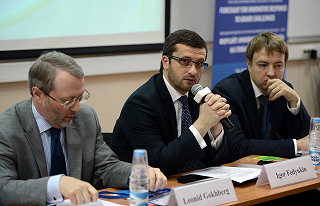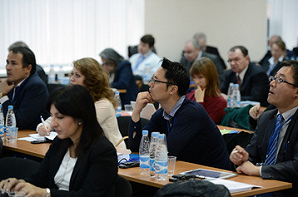At Foresight frequency: broadcasting signals from the future
International scientific conference Foresight: Innovative Answers to Global Challenges, organised jointly with the Organisation for Economic Cooperation and Development (OECD), was held at the Higher School of Economic on 18-19 October, 2012. For Russian long-term futures research experts, it was a major venue for discussing promising areas of future-oriented studies.
International scientific conference Foresight: Innovative Answers to Global Challenges, organised jointly with the Organisation for Economic Cooperation and Development (OECD), was held at the Higher School of Economic on 18-19 October, 2012. For Russian long-term futures research experts, it was a major venue for discussing promising areas of future-oriented studies.
After 6 years of work, the International Research and Education Foresight Centre of the Institute for Statistical Studies and Economics of Knowledge (ISSEK) of the HSE has secured an excellent reputation among futures experts. In addition to regularly held seminars (academic and methodological), the annual scientific conference has become a tradition. This year it was organised jointly with the Organisation for Economic Cooperation and Development (OECD) — the universally renowned “think tank” and best-practice databank on major areas of economic and social policy. A day before the conference began, the second annual meeting of the Foresight Centre’s International Advisory Board took place, where participants discussed major “development vectors” of futures research, and ways to upgrade staff’s competencies needed to ensure the Centre continues to work efficiently.
|
Speakers at the international scientific conference Foresight: Innovative Answers to Global Challenges OECD: Mario Cervantes — principle administrator, Directorate for Science, Technology and Industry (France) Pierre-Alain Schieb — member of Advisory Group of the OECD General Secretariat, Head of Futures Projects implemented by the OECD Directorate for Science, Technology and Industry (France) Michael Keenan — analyst, OECD Directorate for Science, Technology and Industry (France) ISSEK HSE: Leonid Gokhberg — first vice rector, director of the ISSEK Alexander Sokolov — deputy director of the ISSEK, director of the ISSEK’s Foresight Centre Ian Douglas Miles — head of ISSEK’s Innovation Economics Laboratory, professor at the Manchester University (UK) Jean Guinet — head of ISSEK’s S&T Research Laboratory Thomas Terner — deputy head of the ISSEK’s Laboratory for Economics of Innovation Dirk Meissner — deputy head of ISSEK’s S&T Research Laboratory Oleg Karasev — deputy director of the ISSEK’s Foresight Centre Alexander Chulok — head of S&T Forecasting Section of the Foresight Centre The University of Manchester (UK): Luke Georghiou — vice-president for research and innovation of the Manchester University (UK) Özcan Saritas — editor-in-chief of the international Foresight journal, member of the Institute of Innovation Research of the Manchester University (UK) Philip Shapira — professor, Manchester University (UK), professor, Georgia Institute of Technology (USA) Leading Foresight experts — representatives of other research organisations Jonathan Calof — professor, Ottawa University (Canada) Kerstin Cuhls — Fraunhofer Institute for Systems and Innovation Research,Heidelberg University (Germany) Jennifer Cassingena Harper — policy consultant, Malta Council for Science and Technology Byeongwon Park — director, Centre for Strategic Foresight, theScience and Technology Policy Institute (Republic of Korea) Representatives of relevant government ministries Igor Fedyukin — deputy RF minister of education and science Grigory Senchenia — advisor to the RF minister of economic development |
Leonid Gokhberg, Igor Fedyukin, Grigory Senchenia
Participants of the Foresight Days at the HSE were unanimous in their assessment of these October events as “landmark” ones. In his opening speech Leonid Gokhberg, first vice rector of the HSE, stressed that the conference was timed to mark the 10th anniversary of the ISSEK; in a way it would summarise results of the institute’s projects and set new research directions. Pierre-Alain Schieb, head of the OECD Futures Projects, said that the conference was a major contribution to stepping up international cooperation, and expressed his confidence that Russian experts and research institutes would bring new input to this international conference (currently Russia is at the final stage of becoming a member of the OECD). The OECD was also represented by members of the Directorate for Science, Technology and Industry Mario Cervantes and Michael Keenan. The conference participants were welcomed by representatives of relevant government ministries. Igor Fedyukin, Deputy RF minister of education and science, noted the issues on the agenda where especially important in light of active development of government programmes to promote science, technology and basic research, and relevant federal targeted programmes. According to the speaker, the key objectives of these activities were to develop a strategy for Russian S&T policy aimed at increasing the efficiency of investments into R&D, and setting a system of relevant priorities. In Mr Fediukin’s opinion, long-term futures research tools can play a fundamental role in this process. Mr Grigory Senchenia, advisor to the RF minister of economic development, reported that the Government instructed the Ministry of Economic Development, Ministry of Industry and Trade and Ministry of Education and Science to set up a system for forecasting technological development, based on Foresight methodology and oriented towards meeting the demand of the manufacturing sector, subsequently to be extended to cover other sectors of the economy. Mr Senchenia stressed that the HSE was a key ideologist of developing a forecasting system, so the federal authorities were very much interested that the conference results would find practical application in developing specific tools for the above-mentioned system.
|
Foresight as a policy-shaping tool
S&T policy and Foresight traditionally go hand-in-hand. Note that Foresight is not just a tool for shaping policy, but also can be used to increase efficiency of various structures – government agencies, research organisations, private companies. Speakers participating in the first session of the conference — Future S&T and Innovation Policy — presented their ideas from the perspective of this “optimising” function of Foresight.
The OECD representative Mr Mario Cervantes delivered two papers at the conference. In the first one he described his organisation’s positions regarding new S&T and innovation policy trends, and told about the challenges decision-makers are facing. The second paper was devoted to priority setting and strategies underlying S&T and innovative policies of the OECD member countries. According to the speaker, Foresight and roadmaps help these countries to set S&T and innovation policy priorities. Speaking about strategies, he noted that the civil society is becoming increasingly involved in these processes. Accordingly, the fundamental issue of funding (how much to invest in which area?) is supplemented with a problem of representing the interests of all involved stakeholders, and the issue of efficiently managing their interaction.
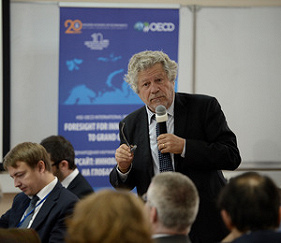 |
| Jean Guinet |
Jean Guinet, head of the HSE ISSEK’s S&T Research Laboratory, analysed key aspects of S&T and innovation policy through the prism of the latest trends in the field of innovation activities, in social, economic and cognitive spheres. Typical models of funding R&D with public money frequently turn out to be inefficient, and require significant restructuring. Due to increasing complexity of the innovation system the issues of management, taxation, intellectual property and development of innovation standards become ever more important. According to the speaker, crucial issues include reducing administrative barriers; finding a balance between existing and emerging innovations; involving all stakeholders into development of innovation policy; and promoting private-public sector partnership.
Leonid Gokhberg, citing provisions of “Strategy 2000”, told about the current agenda of the Russian S&T and innovation policy, highlighted its key challenges, short- and long-term objectives. He also quoted Russian figures from the latest Global Innovation Index 2012, which suggest that despite the relatively high quality of human capital and high productivity of the research sphere, institutional conditions and market environment in the country remain completely counter-innovative. Mr Gokhberg provided a detailed analysis of strengths and weaknesses of the Russian S&T and innovation policy and their interconnection (e.g. stricter budgetary limitations combined with significantly increased R&D funding).
Jennifer Cassingena Harper of the Malta Council for Science and Technology told about the new EU Framework Programme for research and innovation development “Horizon 2020”, to replace the 7th Framework Programme (FP7) after its completion in 2013. She noted the new programme’s flexibility in terms of the scope to discuss problems, budgets, and participation rules, and described the main aspects of innovation policy of interest to industry, academic community and the public sector.
Kerstin Cuhls, head of Foresight projects at Fraunhofer Institute for Systems and Innovation Research, spoke about integrating Foresight into the process of policy shaping, and presented Germany’s experience in this area. The speaker gave such examples as a series of Delphi surveys, the FUTUR programme, the cycle of Foresight studies for the German Federal Ministry of education and research, etc. According to her, Foresight’s success is primarily dependant on how realistic are stakeholders’ expectations; on the timing of conducting relevant studies; and on early involvement of decision-makers into the process.
Foresight as a tool for meeting global challenges
The global challenges problem moved to the forefront of Foresight studies in recent years. In the long term, these challenges have a profound effect on various aspects of the society, all over the world, while finding adequate solutions requires involvement of as many stakeholders as possible. The second session of the conference — Meeting Global Challenges — was devoted to these issues.
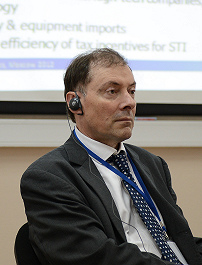 |
| Luke Georghiou |
Luke Georghiou, vice-president of the Manchester University, told about global challenges’ effect on the policy shaping process. The global economic crisis led to an overall reduction of investments, and thus undermined the foundation of sustainable economic growth — i.e. funding of innovation activities. The speaker noted that selection of priority areas for meeting global challenges, and development of ways to apply global solutions should be based on methodologies like Foresight, and involve assessment of required social and economic resources.
Alexander Sokolov, director of the HSE ISSEK’s Foresight Centre, spoke about global challenges in the context of Russian futures studies, in particular long-term forecasts of S&T development; roadmaps for specific industries, corporations and product groups; monitoring of global technological trends, etc. Thousands of experts from dozens of Russian regions are involved in these studies. Identification of key development trends in specific areas helps to identify specific threats and opportunities the country faces due to global challenges, and to design efficient S&T and innovation policy solutions.
Ian Miles, head of the ISSEK’s Innovation Economics Laboratory and professor at the Manchester University, analysed the nature of global challenges. Due to their complexity and multiple dimensions, finding specific final solutions is not an easy task. That’s why, according to the speaker, the search for solutions shouldn’t be limited to technological sphere. Modern technologies are primarily profit-oriented, they have side effects and can engender new problems. Foresight also faces internal global challenges: 1) sharing experience and pooling knowledge; 2) forecasting “disruptive innovations” which significantly affect development of new industries and redistribution of major forces on existing markets; 3) involvement of all stakeholders, and making relevant information available to general public.
Alexander Chulok, head of the HSE ISSEK’s S&T Forecasting Section, presented a paper on the Long-term forecast of S&T development in Russia, in the framework of which experts are working on identification of social, economic and technological trends in six priority S&T areas (ICT, medicine, energy etc.), and analyse relevant challenges and opportunities. On the basis of the long-term forecast, innovation development strategies should be developed for the most promising real sector areas, as well as recommendations for S&T and innovation policy.
Oleg Karasev, deputy director of the HSE ISSEK’s Foresight Centre, told about futures studies conducted at the HSE for corporate clients, specifically about the project commissioned by RUSNANO. In the course of the project were analysed nanotechnology-based solutions for providing adequate supply of pure drinking water to population. The need for this resource drives the demand for innovative solutions, in water treatment and various other industries including nuclear power engineering, medicine and microelectronics. The end result of the project was a roadmap presenting key objectives for water treatment industry, development stages of the most promising technologies and products, their market prospects, and sales forecasts.
Thomas Terner, leading research fellow at the HSE ISSEK’s Laboratory for Economics of Innovation, analysed one of the global challenges – depletion of natural resources, specifically food and energy. The speaker presented data suggesting that global food reserves were steadily declining year after year. Speaking about possible solutions, Mr Terner mentioned labelling of crop genomes to add new genetic properties; improving crops quality in environments with water shortages and inferior soil; increasing various crops’ genetic resistance to biological stress. The speaker noted that in a way society sees application of biotechnology as yet another global challenge, even though the objective is overcoming food shortages.
Foresight as a high-precision tool
At the third session, devoted to strategic intelligence tools, the experts concentrated on fine-tuning and optimising various Foresight instruments.
Jonathan Calof, professor at the Ottawa University, started his paper with a discussion of the term “strategic intelligence”, defining it as a process of companies’ monitoring their competitive environment and analysing incoming signals, as basic input for making decisions. He named the main stages of strategic intelligence: information gathering (20–35% of the total time), analysis (25–30%), communication (10–15%), evaluation and management (10–15%), and planning (10–15%). The relevant methodology includes SWOT analysis, scenarios, problem analysis, S-curves analysis, and STEEP. According to Mr Calof, “strategic intelligence agent” must on the one hand have hard skills (analyse various information sources and gaps, develop methodologies, plan), and on the other hand, soft skills (establish contacts, communicate, understand customers’ psychology, be objective and open to new solutions),
Michael Keenan of the OECD told about the joint OECD – World Bank project: a new innovation policy platform which offers analysts and decision-makers mutual learning and knowledge sharing opportunities. The platform would include structured data such as statistics, country profiles, analytical papers and reports, case studies, scientific publications, manuals for making strategic decisions, forecasts, scenarios and other information relevant to shaping innovation policy. The launch of the platform is scheduled for the spring of 2013.
His OECD colleague Pierre-Alain Schieb presented a new study conducted by this organisation, aimed at designing political responses to possible future shocks. Assuming a large scale and rapid distribution of the threats, five potentially dangerous challenges were selected: pandemics, financial crises, cybersecurity, solar storms and social unrest. Thanks to the lessons learned from analysing case studies relevant to the above problems, possible action plans were drafted, including development of national ongoing monitoring systems; increasing preparedness for unforeseen developments; ensuring adequate diversity of challenge prediction models, etc. Cooperation between public and private sectors would play an important role in achieving these objectives.
Byeongwon Park of the Science and Technology Policy Institute (Seoul, Korea) told the audience about Korean Foresight studies of extreme developments. The country has reached a critical point in economic growth, after which both further progress (albeit on a more modest scale), and rapid decline are possible, which prompts the government to turn to experts for potential solutions. The project undertaken by the institute’s experts resulted in development of “sustainability portfolios” for particularly relevant scenarios, such as problems with internet communications, fluctuations of energy prices, proliferation of nuclear power stations, official introduction of 75 years retirement age. The speaker noted that an important aspect of the extreme developments problem (meeting the challenges and realistically assessing the threats) was preparing the society for them.
Dirk Meissner, deputy head of the ISSEK’s S&T Research Laboratory, elaborated on the idea of Foresight’s relevance for shaping innovation policy, presenting it in the form of designing “policy for innovation”. He noted that authorities frequently base their decisions on the “vogue for innovations” – without having any idea about possible long-term consequences. Mr Meissner stressed the importance of analysing possible implications of decisions taken now for the generation living in 2025-2030 and beyond, in the course of policy shaping process.
Philip Shapira, professor at the Georgia Institute of Technology (USA) and the Manchester University (UK), devoted his paper to nanotechnology development stages. Analysis of three generations of forecasts revealed that proliferation of nanotechnologies depended on investment in such areas as physics and medicine. The researcher tried to identify the reasons why previous estimates (according to which nanotechnology-related market was expected to reach $2.6 trillion by 2014) were exaggerated several hundred-fold. In his opinion, the main reasons included insufficient contacts between nanotechnology experts and the people who shape policy, and excessive expectations of progress in this area.
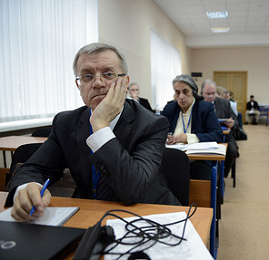 |
| Alexander Sokolov |
The final presentation at the session was by Özcan Saritas from the Manchester University’s Institute of Innovation Research. He presented preliminary results of a project on scanning global technology trends, implemented jointly with the HSE ISSEK. A huge amount of unstructured data on this subject determines crucial importance of choosing the “right” sources of information, and the right approaches to analysing it. The project methodology comprises the following stages: preparing a list of keywords describing the field in question; preparing analytical basis using key data sources; clustering and developing a draft list of trends; validation of the identified trends; and collecting detailed information for each of them. Having outlined the prospects revealed by the obtained results, Mr Saritas concluded his presentation by a bold suggestion that the nature of researchers’ work may drastically change in the next 10-15 years.
Summarising the conference results, Mario Cervantes of the OECD noted the high quality of debates and reviewed key issues stressed by many of the speakers: importance of the global challenges problem, priority setting, and further development of Foresight tools. According to him, in the 21st century we should evaluate technologies developed in the 20th century. Due to emergence of new trajectories for development of science and society, of new approaches and new ways to implement strategic decisions, policy designers and decision-makers must adopt certain stable and clearly understandable indicators, and the OECD provides a good platform for that.
Alexander Sokolov, deputy director of the HSE ISSEK, underlined the main points of each speaker’s presentation and thanked the experts for valuable recommendations regarding further development of the HSE ISSEK’s Foresight Centre, suggested during the conference and the meeting of the Advisory Board.
The material prepared by N.S. Mikova, I.D. Vorobieva, Y.V. Popov, N.G. Timshina


